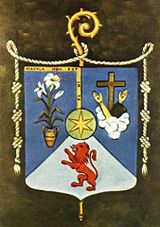- Conceptionists
-
Order of the Immaculate Conception of Our Lady 
Abbreviation Order of the Immaculate Conception (O.I.C.) Formation Late 15th century (by Saint Beatrice of Silva) Type Catholic religious order Website www.concepcionistas.info The Order of the Immaculate Conception (Ordo Inmaculatae Conceptionis), also known as the Conceptionists, are a contemplative Order of nuns.[1] For five hundred years, they followed the Poor Clare Rule, but were recognized as a separate Order, .
Founded in 1484 at Toledo, Spain, by Saint Beatrice of Silva, sister of the Blessed Franciscan friar, Amadeus of Portugal. On the marriage of Princess Isabel with King John II of Castile, Beatrice had accompanied the future Queen, her cousin, to the court of her new husband. After the marriage, however, her great beauty aroused the jealousy of the Queen, for which she was imprisoned. During that time of incarceration, Beatrice experienced an apparition of the Blessed Virgin Mary, telling her that the Blessed Mother wanted her to found a new Order in her honor.
Beatrice escaped with difficulty and took refuge in the Dominican Second Order monastery at Toledo. There, for forty years, she led a life of holiness, however without becoming a member of that Order. In 1484, Beatrice, with some companions, took possession of a monastery in Toledo (now the Monastery of the Order of the Immaculate Conception) set apart for them by Queen Isabel .
In 1489, by permission of Pope Innocent VIII, the nuns adopted the Cistercian Rule, bound themselves to the daily recitation of the Divine Office of the Immaculate Conception, and were placed under obedience to the Ordinary of the diocese. In 1501, Pope Alexander VI united this community with the Benedictine community of San Pedro de las Duenas, under the Rule of St. Clare, but in 1511 Julius II gave it a Rule of its own. Special constitutions were drawn up for the Order in 1616 by Cardinal Francis Quiñones.
A second monastery was founded in 1507 at Torrigo, from which, in turn, were established seven others. The congregation soon spread through Portugal, Spain, Italy, and France, as well as in Portugal's colony of Brazil. (That community, however, later separated from the monastic Order to become a religious congregation of missionary Sisters of the Third Order of St. Francis.) The foundress determined on the habit, which was white, with a white scapular and blue mantle.
The foundress, Beatrice Meneses da Silva was canonized by Pope Paul VI in 1976. Her feast day is 1st September.
Going back to the roots
A major change in the interior life and spiritual orientation of the Order developed at the end of the 20th century. The Second Vatican Council had instructed all religious Institutes to go back to the inspirations and goals of their founders and to make sure that their current orientation and lifestyles of the communities were in keeping with these.
Through the the studies done by Mother Mercedes de Jesús Egido y Izquierdo (1935-2004), a new direction was developed and tried on an experimental basis at her monastery. After a trial of two years, new Constitutions were drawn up out the experience, which were submitted to Rome and approved by the Holy See in 1996 for this Order, removing from it the noticeable Franciscan influence imposed upon it by the papacy. Mother Mercedes successfully argued that the Foundress' vision was that of a life lived in imitation of the virtues of the Blessed Virgin Mary. She has become seen as a second foundress through her efforts.
The process for seeking Mother Mercedes' canonization was formally opened at the Monastery of the Immaculate Conception and St. Beatrice in Toledo on November 8, 2011.
External sources
- Website of the Conceptionist nuns of the Monastery of Alcázar de San Juan, Spain [1](Spanish)
References
- ^ "Congregation of the Immaculate Conception". Catholic Encyclopedia. New York: Robert Appleton Company. 1913. http://www.newadvent.org/cathen/07681a.htm.
 This article incorporates text from a publication now in the public domain: Herbermann, Charles, ed (1913). Catholic Encyclopedia. Robert Appleton Company.Categories:
This article incorporates text from a publication now in the public domain: Herbermann, Charles, ed (1913). Catholic Encyclopedia. Robert Appleton Company.Categories:- Roman Catholic female orders and societies
- 1484 establishments
- Poor Clares
- Christian religious orders established in the 15th century
Wikimedia Foundation. 2010.
